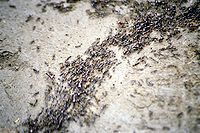
Photo from wikipedia
Abstract Signals acquired from non-specific chemical sensors contain significant amount of irrelevant information regarding the targeted characteristics of the experimental analytes. Feature selection process weeds out the redundant information and… Click to show full abstract
Abstract Signals acquired from non-specific chemical sensors contain significant amount of irrelevant information regarding the targeted characteristics of the experimental analytes. Feature selection process weeds out the redundant information and supplies a dimensionally reduced informative dataset for the system to achieve an improved performance. Considering the complex interaction among the features and also the large number of possible subsets, it is necessary to develop advanced strategies to handle the difficult feature selection problem. In this study, genetic algorithm (GA) was equipped with a dynamic memory, and an adaptive mechanism was developed to reconstruct potential chromosomes from the memory. The modified model was implemented on binary and continuous GAs, and they were applied for feature selection from a metal-oxide semiconductor gas sensor array to increase the sensors’ selectivity in classifying storage duration and type of rice crops. When there was no prior knowledge on the optimal (or required) number of features, different switch parameters were embedded in the algorithms to control the feature subset size and the selectivity of the sensors. It was observed that the system error was decreased by utilizing smaller subset of features rather than the whole responses, revealing that the signals were conveying great amount of noise. The modified GAs outperformed the conventional methods in reducing the response dimensionality as well as the system error. The incorporated switch parameters gave the decision maker the ability of balancing the number of features and the accuracy of the system. Finally, the developed algorithms could be applied as successful strategies to select optimum responses from sensor array signals.
Journal Title: Chemometrics and Intelligent Laboratory Systems
Year Published: 2021
Link to full text (if available)
Share on Social Media: Sign Up to like & get
recommendations!